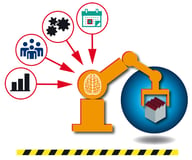How Do You Measure Supply Chain Resilience?
Brian Hoey - January 12, 2021

According to a paper that came out last year, there were a number of factors that acted as strong predictors of supply chain resilience. The paper sketch out resilience itself as a function of being able to anticipate a disruption, resist the negative effects of that disruptions, and respond quickly and decisively to changing conditions as needed. In order to be able to accomplish all that, supply chains had to be agile, flexible, and adaptable—but they also had to be built for collaboration, speed, and security, while utilizing robust network designs and highly visible IT frameworks.
As you can imagine, resilience has become an even more important topic since the paper was published. Supply chain managers around the world are quickly getting a sense of how resilient their networks actually are to the volatility of complex global supply networks—and they’re often less than pleased with the results. For that reason, in the coming years, resiliency is likely to loom larger and larger in the minds of supply chain planners, logistics planners, and other stakeholders up and down the value chain. But how exactly can we quantify something as nebulous as resilience—and how can planners measure the level of resilience that their supply chains already attain?
1. Collaboration
Perhaps the most important element of your supply chain’s ability to overcome—or even profit off of—unexpected changes and developments is the one that’s most difficult to measure objectively: collaboration. The more effectively a particular business process or network is set up to empower collaboration in the planning process, the less likely it is to encounter disruptions that it can’t withstand. In this context, collaboration is function of a few things:
- Technology integration up and down your own internal software environment, such that different planning functions can all work together cross-functionally as needed
- Supply chain integration with partners and suppliers that enables you to share information and collaborate with others outside of your own organization
- Tools that actually empower collaborative planning processes, such as digital twins and other sandbox planning environments.
While there might not be a single number you can attach to your assessment of your collaborative capabilities, looking for these three things (or their absence) should give you a solid indication of how you’re faring in that department.
2. Forecast Error
Now we get into the more quantitative measurements. Like we mentioned in the opening paragraph, the first step to resilience is being able to sense and anticipate changes and disruptions. This means that with something like a freight capacity shortage or a large demand spike for a particular product, you’re able to identify the possibility of a disruption well in advance and take proactive steps (e.g. purchasing freight capacity before your real orders come in or adjusting your production ratios ahead of time) to ward off any unwanted effects. Thus, figuring your resilience in this regard is a simple matter of measuring the accuracy of your forecasts by comparing what was predicted against what actually happened and determining the percent error. The greater your percent error across your various forecast types, the less likely you are to see supply chain changes coming and make changes that will help you avert them. Conversely, the smaller your error percentage, the better you’re positioned to weather volatility.
3. Data Velocity and Availability
On a fundamental, there is a connected thread between many or most of the elements of a supply chain that’s less susceptible to disruption. For instance, data is crucial for improving forecasts, but it’s also critical in its own right. In a truly resilient supply chain, data will be plentiful and it will move quickly throughout your enterprise and potentially various partner enterprises. In this way, you’re able to analyze situations more quickly and thus act more quickly when the time comes. This is another measure where you may begin with gut-check answer to a few questions:
- Is the information you need to access always up-to-date?
- Is that information always complete?
- If not, are there particular areas where there are identifiable silos?
- Are any of your workflows empowered with real-time data and information flows?
- If so, how many? How many other, similar workflows could be operating with real-time data but aren’t?
Based on your answers here, you can begin to give yourself a data management grade. You can also go through some of the criteria for data visibility that we lay out in this post.
4. OEE
Simply put, factories that often find themselves dealing with unplanned idle time aren’t well set up for true resilience. After all, if you can’t count on your plants to produce a high ratio of good parts at a huge rate of uptime, you may not be able to rely on them in a real time-crunch resulting from a supply chain snafu. Thus, to get a sense of how prepared you are to actually make use of any planning agility and flexibility you’ve demonstrated above, you’ll need to measure your OEE, or overall equipment effectiveness. This is a function of a few things:
- Quality—what percentage of parts you produce are good?
- Availability—how much uptime do you have versus stoppages?
- Performance—are your production runs as fast as they should?
Calculate each of these as a percentage and then multiply the percentages to get your OEE score. Similar formulas can also be extended to transport activities and the like. A high score suggests resilience, while a low one is a big hint that you have work to do.
Taken together, the four metrics that we’ve sketched out in this article should give you a solid foundation for measuring your level of resilience throughout your supply chain. While it’s difficult to give a set of objective measures for what a “good” score is on any of the above, you can measure now to establish a baseline, and then measure again in a few months to see whether your efforts to improve resilience are working. If your numbers are stagnating, you may need to shake up your approach.
If you want to learn more, download your guide to Transformation of Manufacturing Processes.
In this Guide you will learn:
-
Emerging Challenges in the Modern Truck/Automotive Industry
-
How Can Global Companies Adapt to These New Realities
-
How Decentralized Digital Systems Power Smarter Planning Processes
-
How flexis Can Support Flexible Supply Chain Transformation
LATEST POSTS
- Understand Why Production Planning Needs Specialized Solutions
- Understand Circular Economy in The Manufacturing Industry
- How Can Industry 4.0 IT Integration Be Achieved Smoothly?
- The Significance of Order Sequencing in Discrete Manufacturing
- How to improve your Supply Chain Management: The Power of Control Towers



